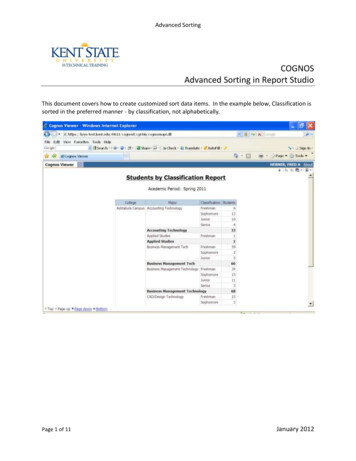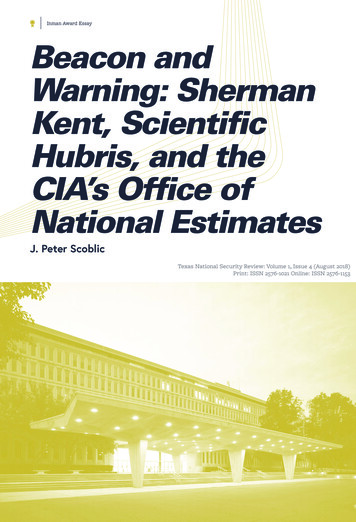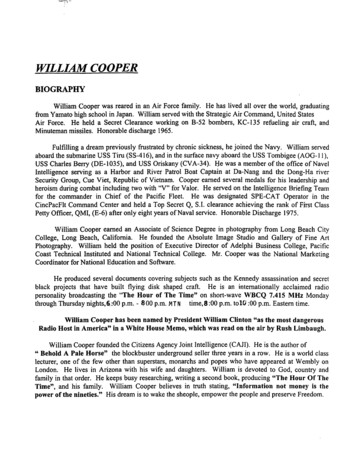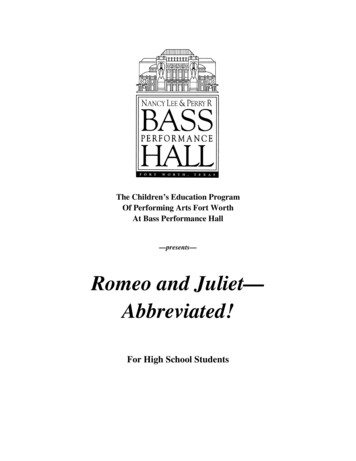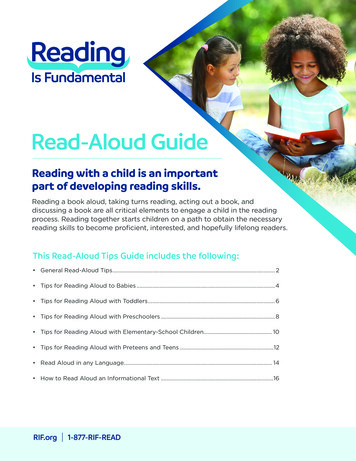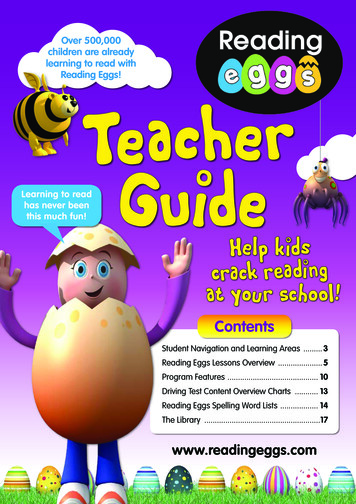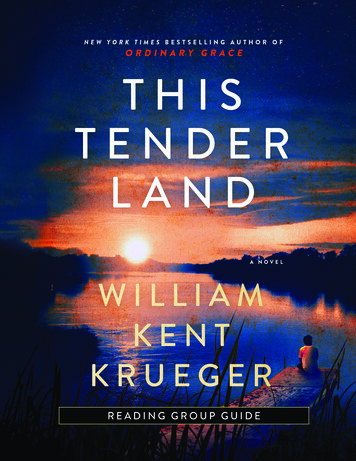
Transcription
READING GROUP GUIDE
This reading group guide for This Tender Land includes anintroduction, discussion questions, and ideas for enhancing yourbook club. The suggested questions are intended to help yourreading group find new and interesting angles and topics for yourdiscussion. We hope that these ideas will enrich your conversationand increase your enjoyment of the book.INTRODUCTIONIn Minnesota, in the summer of 1932, on the banks of the Gilead River, the Lincoln Indian TrainingSchool is a pitiless place where Native American children, forcibly separated from their parents, aresent to be educated. It is also home to Odie O’Banion, a lively orphan boy whose exploits constantlyearn him the superintendent’s wrath. Odie and his brother, Albert, are the only white faces amongthe hundreds of Native American children at the school.After committing a terrible crime, Odie and Albert are forced to flee for their lives along withtheir best friend, Mose, a mute young man of Sioux heritage. Out of pity, they also take with them abrokenhearted little girl named Emmy. Together, they steal away in a canoe, heading for the mightyMississippi in search of a place to call home. Over the course of one unforgettable summer, thesefour orphan vagabonds journey into the unknown, crossing paths with others who are adrift, fromstruggling farmers and traveling faith healers to displaced families and lost souls of all kinds.
TOPICS & QUESTIONS FOR DISCUSSION1.Although Odie and Albert find themselves in a boarding school for Native American children, mostof the Native children don’t actually speak in the story. The Native character whom readers get toknow best is Mose, and he is mute and “speaks” only through sign language. Why do you think theauthor chose silence as a way of depicting the children at the school?2.Trying to understand the nature of God is one of the many struggles for Odie during his experiencesin the summer of 1932. Is Odie the only one struggling with this issue? What sense do you haveconcerning the way the other vagabonds feel about the nature of God? What about the people theymeet on their travels? How does Odie’s relationship with God change over the course of his journey?3.When Odie and Albert attempt to buy boots, the clerk is skeptical that Albert and Odie would beable to afford the 5 price tag. After Odie lies about getting the money from their father, a secondclerk remarks, “If he got a job these days, he’s one of the lucky ones.” This is Odie and Albert’s firstexperience of life outside of the Lincoln School. What sense of the current state of the world do youget from this encounter?4.When Odie is working for Jack in his orchard, Jack explains his religious philosophy, saying, “God allpenned up under a roof? I don’t think so.” Where does Jack think God is really to be found? Whatis it in Odie’s experience that makes him disagree with Jack’s outlook?5.After having escaped Jack, the vagabonds encounter a Native American man named Forrest. Heappears friendly and shares a meal with them, but he’s also aware that there is a 500 reward for theircapture—a huge amount of money at the time. The children are unsure whether to trust him or not.What would you do in their situation?6.Tent revivals—places where Christians would gather to hear religious leaders speak—were commonin the Great Depression, often traveling across the country from town to town. They offered hopeto people in desperate times, as Sister Eve does to Odie, Albert, Emmy, and Mose. However, Albertis skeptical of Sister Eve’s healings, calling her a con. What do you believe about Sister Eve’s abilityto heal? What is the con that Albert is warning Odie about?7.Why does Odie trust Sister Eve so wholeheartedly, but not her partner, Sid? Do you think he’sright to draw the conclusions he does about Sid from their interactions? How do some of Odie’smisjudgments lead to disastrous consequences? In your opinion, is what happens to Albert in someway Odie’s fault?
8.When the vagabonds encounter the skeleton of a Native American boy, Albert says there’s nothingthey can do, but Mose reacts very differently. Later, he wanders off from the group to learn aboutthe Dakota Conflict of 1862, which resulted in the execution of thirty-eight Sioux and the deathsof hundreds more. How does knowledge of this history change how Mose perceives himself? Whatimpact does hearing this story have on Odie? On you?9.Hoovervilles (named for President Herbert Hoover) were shantytowns that sprang up all acrossAmerica during the Great Depression for homeless individuals and families. In difficult times likethis, how do people like the Schofields survive? Is there an expectation that the government willhelp them, or do they look to other sources for assistance? How do the residents of this particularHooverville pull together? How are they driven apart?10.The Flats is like no other place the vagabonds have been on their journey. What makes it so unusual?When John Kelly is stopped by a policeman, why does he feel he has to say he is from a different partof town? Despite making a new friend, why is Odie so unhappy during the time he spends there?11.When Odie is on his own, riding the rails, trying to get to St. Louis, he comes face to face with dangerand violence. Do you think he was foolish for striking out alone? How was this encounter differentfrom the things he experienced at Lincoln School?12.Odie is a born storyteller even at his young age. Throughout the book he tells Albert, Emmy, and Mosetales about an imp, a princess, and the vagabonds. What purpose do these stories serve in the novel?13.Sister Eve says to Odie that the only prayer she knows will absolutely be answered is a prayer forforgiveness. What do you think she means by this? Who are the people whom Odie needs to forgive,and for what reasons?14.Odie, Albert, Mose, and Emmy are all searching for peace and a place to call home. What do youthink each character is looking for and what are their different definitions of home? In the end, dothey all find what they are looking for, and if so how?15.The author has said that he drew inspiration from the works of Mark Twain, Charles Dickens, andHomer. Do you find elements of works by those authors in This Tender Land? Why or why not? Arethere other authors whose work this story calls to mind?16.In the story, Odie speaks of the journey he and the others are on as an odyssey. Do you see echoes ofHomer’s epic poem in the children’s experiences? If so, can you identify Homer’s poetic counterpartfor each section of the story?
ENHANCE YOUR BOOK CLUB1.For your next book club gathering, plan to meet somewhere outdoors and go on an adventurewhether by foot or canoe. Discuss with your group what you notice about the landscape around you.How is the Midwestern landscape a part of Odie’s story? What connections to This Tender Land canyou make to your own life and the place that you live?2.Download the This Tender Land Spotify playlist and listen to some of the songs with your group.Discuss your favorite scenes in the book that feature music and how it changes your reading experienceto hear the songs alongside them. Do you think the songs enhance the story? How?3.Similar books about coming of age over one season like The Body by Stephen King and This Boy’s Life byTobias Wolff have been adapted to the big screen. (The film based on The Body was titled Stand by Me.)If This Tender Land were turned into a film, which actors would you want to play the main characters(Odie, Sister Eve, Mrs. Brickman, et al.)? What scenes from the book would you most like to see onthe big screen?
A Q&A WITH WILLIAM KENT KRUEGER,AUTHOR OF THIS TENDER LAND1. How did the characters of Odie, Albert, Emmy, and Mose first come to you, and why didyou want to tell their story?WKK: The seed of the story had been with me for years, the idea of a couple of kids, one white, oneNative, fleeing down the Mississippi River, a kind of update of Adventures of Huckleberry Finn. As thestory grew in my thinking, the cast expanded—an older brother to add the emotional complexity offamily, a little girl who would need protection so that there would be an element of knightly honorto the tale. The depth of their characters and the true nature of their relationship to one anotherrevealed themselves to me gradually. But as I watched the spiritual ties of the Vagabonds grow everstronger and their deep feelings for one another blossom in such beautiful ways, I fell in love withthese children and was absolutely compelled to see their journey to the end.2. Why did you decide to write a story set against the backdrop of the Great Depression?WKK: I wanted to write a story about the beauty of the human spirit, what I believe to be its capacityfor resilience and for remarkable generosity in the face of great privation. The Depression, with itschallenges and hardships on such a massive scale, seemed the perfect backdrop for such a story.3. What kind of research did you do when you were writing This Tender Land? Did anythingsurprise you as you were writing the book?WKK: I pored over tons of newspapers from the era of the Great Depression, trying to nail downprices, clothing styles, newsworthy events of the day. I read numerous first-person accounts of thosewho’d lived through the times: struggling farm families; men and boys—and in some cases, womenand girls—who rode the rails; citizens of the Hoovervilles; and of course, stories of the difficult lives ofchildren forced to live in government-run Native American boarding schools. I studied photographafter photograph that captured the spirit of the people and the time. And I suppose what surprisedme most was how, after doing so much research about this historical period, the setting felt quitenatural to me as I wrote it.4. The novel is divided into five parts. Why did you structure it this way?WKK: In my early thinking of the story, I couldn’t see a structure to the journey on which I wanted mykids to embark. But then the idea of Homer’s Odyssey, one of my favorite tales from childhood, hitme. Why not have their journey be one that mirrors some of the events in Homer’s great epic poem?If you read the story in this light, you’ll see that each stop the Vagabonds make echoes an adventureof Odysseus as he made his way home from Troy.5. What was it like to write from the voice and perspectives of the same character as a youngboy and as an old man?WKK: I have written in this dual voice once before, in my novel Ordinary Grace. With OrdinaryGrace, I had great difficulty at first in managing the smooth transitions between an older, more maturevoice and the voice of an adolescent. But with that experience under my belt, I found it wasn’t quiteso challenging this second time around. What was fun in This Tender Land was having the oldernarrative voice occasionally speak directly to his younger self. Don’t we all wish we could talk to theperson we once were to offer advice and comfort?
6. Family takes on many different forms in This Tender Land. Why was this something youwanted to explore?WKK: In all my novels, including those in my Cork O’Connor mystery series, the two elements Ireturn to most often in constructing my stories are the importance of family and the nature of God.It seems to me these are the two most significant relationships we experience as human beings, andI find exploring them to be infinitely fascinating.7. Odie’s connection to music is a key theme in This Tender Land. What role has music playedin your life? Do you play any instruments?WKK: I sing all the time. It drives my wife nuts. Music has never been a formal part of my life—Idon’t play an instrument and a musical score is Greek to me—but I’ve always loved a good tune.It can lift your spirits or make you cry like a baby. In that way, music is very like a good story. ForOdie, music is solace, music is inspiration, and music is connection. I grew up listening to most ofthe tunes I included in the story, many of them favorites from my childhood. That’s especially trueof “Shenandoah,” which I first heard sung by Jo Stafford on an album of American folk tunes givento me by my parents as a Christmas present when I was eleven, and which I played over and overuntil I’d worn out all the grooves in that old wax platter.8. This novel is quite different from your Cork O’Connor books. What were some ofthe differences in your process, and your relationship to the characters and story, in ThisTender Land?WKK: I owe all the characters in my Cork O’Connor novels a great debt of gratitude, but honestly,they remain characters to me. I manipulate them. I’ve occasionally been cruel in what I’ve thrownat them, some pretty horrible things for the sake of the story. Odie and his fellow Vagabonds weredifferent. I didn’t know them well at first, but as I came to understand their hopes and dreams andvulnerabilities, I really fell in love with them. What I wanted in the end was for these four friends tobe safe and for each of them to find what he or she was seeking.9. This Tender Land contains many allusions to classic literature—Adventures of HuckleberryFinn, The Odyssey, The Wizard of Oz. What other books influenced This Tender Land or shapedyou as a writer?WKK: Because of the setting in the Great Depression and the importance of the landscape, JohnSteinbeck was often on my mind. The horrific conditions in the Lincoln Indian Training School harkback to Charles Dickens and the social consciousness evident in so many of his works. And UptonSinclair was probably always lurking somewhere at the back of my thinking.10. What do you hope readers will take away from this story?WKK: A good story is a journey, not just for the characters involved but also for the writer ofthat story, and for the reader as well. At the end of the journey, everyone involved oughtto be in a different place than when they began, wiser, perhaps, and maybe a bit morecompassionate in their world view. I hope readers see that the challenges the four Vagabondsface in their odyssey—the prejudice, greed, and malice of some human beings—are more thanbalanced by the capacity of the human spirit for generosity and forgiveness. And, of course,I hope that Odie and his companions will have found a place in the hearts of readers everywhere, andthat the story of the Vagabonds’ river journey in the summer of 1932 is one readers will remember fora long time. I’d love for This Tender Land to become one of those novels that people feel compelledto read again and again.
THE CHARACTERS’ JOURNEY DOWN THE MISSISSIPPI RIVER
“It was a beautiful tune, but in a minor key,so there was a sadness to it that settled on us all.”—Odie O’BanionThis Tender Land Spotify PlaylistThe This Tender Land playlist reflects the crucial role of music in the novel. Songs narrate Odie’s journey, Odie is amusician himself, and both the playing of and listening to music become key methods for Odie and his companionsto connect with the important characters they meet during their travels—from Odie playing his harmonica andcomforting Mose with a tune while in the quiet room at the Lincoln School to his serenading the drunken pig scarerin his barn, from the call of the spirituals being performed at Sister Eve’s tent revival to a campfire jam session inHopersville.The list below is of the named songs in This Tender Land, in order of appearance:1.Shenandoah p2312.Buffalo Gals p1692.I Got Rhythm (Red Nichols and The Five Pennies) p2413.Coming Round the Mountain p1693.Meet Me in St. Louis p3614.Ten Cents a Dance p1874.Rock of Ages p6315.Embraceable You p1875.Old Joe Clark p12316.Beautiful Dreamer p1946.Sweet Betsy from Pike p12317.Little White Lies p2307.Red River Valley p12418.Am I Blue p2478.Camptown Races p13119.Arkansas Traveler p2809.Goodbye Old Paint/Leaving Cheyanne p13920.Down by the Riverside p34110.The Yellow Rose of Texas p16621.My Wild Irish Rose p41711.Take Me Out to the Ballgame p166
four orphan vagabonds journey into the unknown, crossing paths with others who are adrift, from struggling farmers and traveling faith healers to displaced families and lost souls of all kinds. INTRODUCTION. 1. Although Odie and Albert find themselves in a boarding school for Native American children, most
